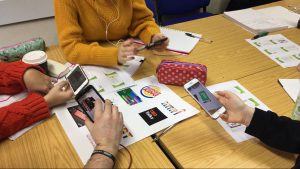Summary of the case study
This case study explores the use of Self-Organised Learning Environments (SOLEs) with a group of about 100 students on a core Level 4 module (‘Orientation to Higher Education & Research’) in the BSc (Hons) Sport & Exercise Sciences during the first semester of 2018/19.
The aim of this module is to provide an orientation to facilitate students’ smooth transition into Higher Education by building and developing their pre-existing skills, enabling them to become more independent and self-managed in their approach to study, learning and time-management. The module also aims to develop students’ understanding of the importance of research and its tools to enable them to engage with the information presented to them, and to develop a scientific approach to their studies. The students attended a weekly lecture (with the whole group), and one smaller seminar group (around 15 in each group).
The project was led by Dr Amy Clark, Lecturer in the School of Human and Life Sciences.
Rationale
Self-Organised Learning Environments (SOLE) is a model of learning which facilitates an enquiry-based learning approach. These involves students self-organising themselves into groups and using a computer connected to the internet to gain specific knowledge, with minimal tutor support. The SOLE’s learning environment is characterised by its “absence from [tutor] intervention” and by “openness and flexibility” (Mitra et al., 2005, p.3).
Whilst Amy had previously utilised SOLE successfully and conducted research surrounding this in an optional sport sociology module (Clark, 2016), she wanted to deliver this innovative teaching practice on a core module in both a lecture and seminar session. Her challenges were that some students, in the past, had approached the module with little enthusiasm, and felt a bit overwhelmed by it, due to the complex nature of the topics covered.
Her aims were to enhance student engagement whilst teaching key research methods concepts. She wanted to ensure that students:
- remained energetic and focused;
- could grasp vital information relevant to their studies;
- became aware of the importance and impact of this particular module on the rest of their studies.
With this in mind, Amy wanted to find out whether the different group sizes would affect the delivery and outcome of the SOLE session.
The activity/project
At the beginning of both types of sessions, Amy briefed students on the SOLE procedure. She then journeyed through the three phases used for SOLE research (taken from Clark, 2016, p.6):
Figure 1: The three phases used for SOLE research.

Students arranged themselves into groups (between 4 and 6) and used only ONE internet source with access to e-Library and Google Scholar. Each group was given flip chart paper and pens. Students brought their own laptops/electronic devices. They were able to look and see what other groups were doing, and take that information back to their own group.
Only one SOLE session was delivered to the larger lecture group, at the beginning of the semester. These students were given 45 minutes to research the following question: What is qualitative research, and what does it consist of?
The other SOLE session was delivered to the smaller seminar group mid-semester (this was also carried out across the rest of the groups with other tutors leading the sessions). The students were given 30 minutes to research the following question: What is a literature review, and what is its purpose?
Once the students had finished researching their question, they presented their findings to the rest of the class (presented on the flip chart paper given). This was following by a discussion, led by the lecturer, on the main areas and vital concepts that needed further addressing.
Evaluation and Benefits [including quotes from students, employers, staff, etc.]
Overall the impact of utilising SOLE proved to be beneficial, but its impact was more positive with the smaller groups than the large group.
Within the larger session (roughly 100 students), the delivery of SOLEs had its difficulties. Whilst students were somewhat engaged in the session and researched the specific question successfully – there were times when students were complaining of others using social media and being distracted, some students even left halfway through and did not return to the session. It may be advantageous, for tutors who have larger groups and choose to utilise SOLE, to possibly have more than one staff member involved if possible. This way, whilst a hands-off approach is necessary for SOLE, students would feel that they are still having valuable contact with the tutor(s) involved, and no group would feel neglected.
The SOLE session delivered to the same group of students, but in a smaller seminar group (roughly 15 students) was overall the most successful session. This occurred in a smaller flexible learning space. The quality of research produced by the students was incredible, and the students were highly engaged and sprightly. For example, a student stated:
Yesterday’s SOLE session on Literature Reviews was so helpful, it worked really well and [I] took so much in! Just wanted to feed that back and say thanks!
It appears that the smaller groups offered a more intimate environment, and allowed for the students to fully concentrate and benefit from the SOLE approach. Students on NLPs/LSPs fully immersed themselves into the session, and even spoke and presented to the rest of the class. The flexible learning space also enabled students to move around the room and work closely in their groups.
Overall the research findings and presentations from the students were outstanding in both sessions. They tackled complex issues and used a variety of academic sources. Additionally, it could also be suggested that their graduate attributes and skills were enhanced through presenting and working within groups, and their digital literacy skills were also challenged. By using additional time after the SOLE session to follow up any queries and questions, a lot of students were very engaged and learnt a lot of new concepts at their own pace. They were also able to manage and organise their own learning time, which helped improve their independent learning skills.
Resources and support [including references, contacts, links to relevant CCCU departments, etc]
Clark, A. (2016) ‘An Investigation into the Impact of Self Organised Learning Environment (SOLE) on Student Engagement in Higher Education’, Online Education Research Journal, 1(4), pp. 1-17. Available at: http://community.dur.ac.uk/p.b.tymms/oerj/publications/102.pdf.
Mitra, S. (2015) SOLE Toolkit: How to bring Self-Organised Learning Environments to your Community. Newcastle, England: Newcastle University. Available at: https://s3-eu-west-1.amazonaws.com/school-in-the-cloud-production-assets/toolkit/SOLE_Toolkit_Web_2.6.pdf.
Mitra, S., Dangwal, R., Chatterjee, S., Jha, S., Bisht R.S. & Kapur, P. (2005) ‘Acquisition of Computing Literacy on Shared Public Computers: Children and the “Hole in the Wall”‘, Australasian Journal of Educational Technology, 21(3), pp. 407-426. DOI: 10.14742/ajet.1328.
If you want to know more about this case study, please contact Amy Clark, School of Human and Life Sciences, CCCU, at amy.clark@canterbury.ac.uk.
 PRISM
PRISM Jack Charter
Jack Charter 1803
1803



